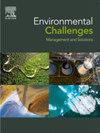Water Footprint Analysis of Wheat Cultivation in the Ganga Yamuna Doab Region – Implications for Sustainable Water Management
Q2 Environmental Science
引用次数: 0
Abstract
The research investigates the Water Footprint (WFP) of wheat cultivation in the Ganga-Yamuna Doab (GYD) region, highlighting grey WFP sub-components like Nitrogen (N), Phosphate (P), and Potassium (K). Blue water footprints dominated (88 %), with nitrogen-related WFP leading among grey components. The average total WFP for wheat in GYD was lower (1165 m3/ton) than the global average. Variations in blue WFP were observed across districts, with efficient water usage in some and higher values in others due to rainfall distribution and agricultural practices. Green WFP averaged 40 m3/ton, indicating varied resource utilization. Grey WFP was higher (98 m3/ton) than India's national average, influenced by urbanization, excessive fertilizer usage, and intensive agricultural practices. Precision farming techniques offer opportunities for greywater footprint reduction. Expert recommendations stress data validation and consider variations in planting/harvesting dates and growing season duration for improved sustainability. Soil characteristics are pivotal in defining crop rooting depth, especially in rain-fed regions. Data validation from reputable sources is crucial for accuracy and reliability.
恒河亚穆纳多布地区小麦种植的水足迹分析——对可持续水管理的启示
该研究调查了Ganga-Yamuna Doab (GYD)地区小麦种植的水足迹(WFP),突出了灰色WFP子成分,如氮(N)、磷(P)和钾(K)。蓝色水足迹占主导地位(88%),与氮相关的WFP在灰色成分中占主导地位。世界粮食计划署在该区的小麦平均总量(1165立方米/吨)低于全球平均水平。在各区之间观察到蓝色粮食计划署的差异,有些地区用水效率高,而另一些地区由于降雨分布和农业做法的原因,数值较高。绿色粮食计划署平均40立方米/吨,表明不同的资源利用。受城市化、化肥过度使用和集约化农业实践的影响,灰色世界粮食计划署(98立方米/吨)高于印度全国平均水平。精准农业技术为减少灰水足迹提供了机会。专家建议强调数据验证,并考虑种植/收获日期和生长季节持续时间的变化,以提高可持续性。土壤特征是决定作物生根深度的关键,特别是在雨养地区。来自可靠来源的数据验证对于准确性和可靠性至关重要。
本文章由计算机程序翻译,如有差异,请以英文原文为准。
求助全文
约1分钟内获得全文
求助全文
来源期刊

Environmental Challenges
Environmental Science-Environmental Engineering
CiteScore
8.00
自引率
0.00%
发文量
249
审稿时长
8 weeks
 求助内容:
求助内容: 应助结果提醒方式:
应助结果提醒方式:


